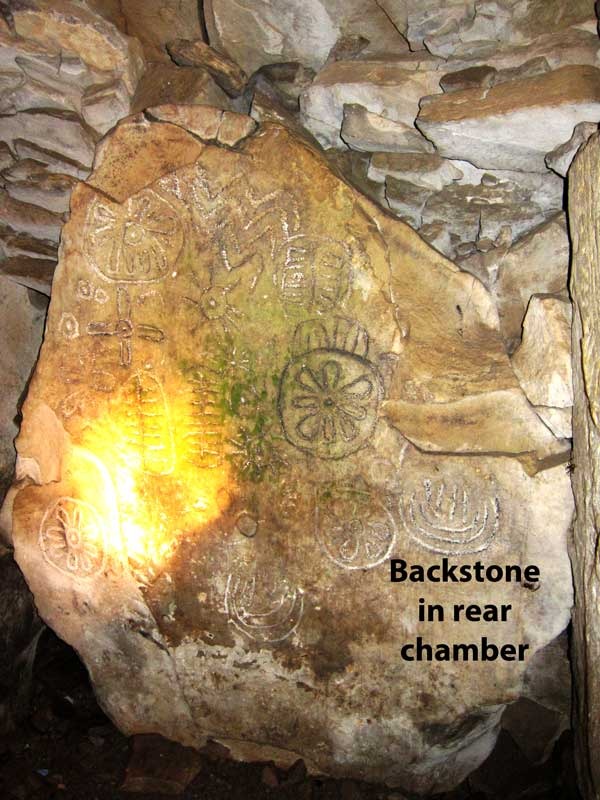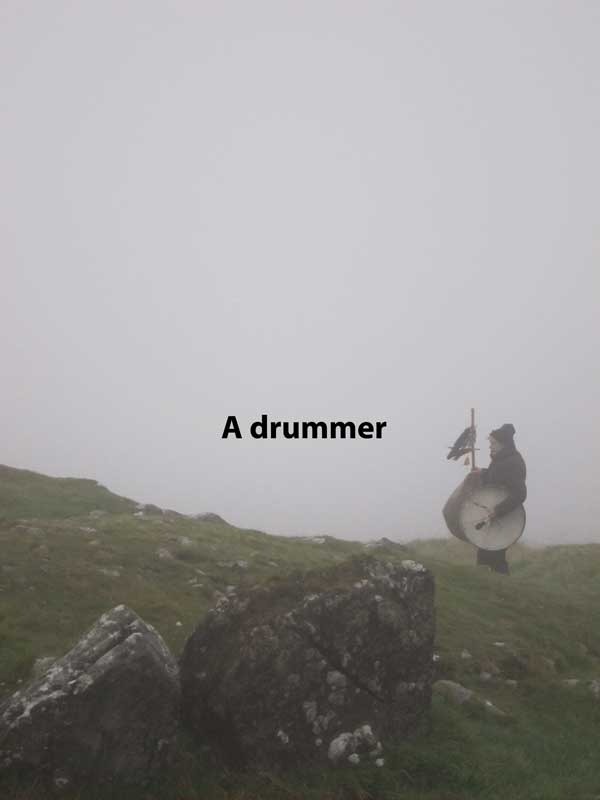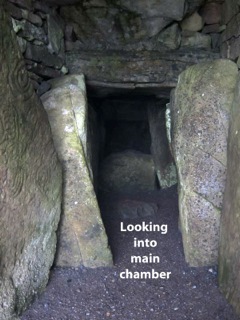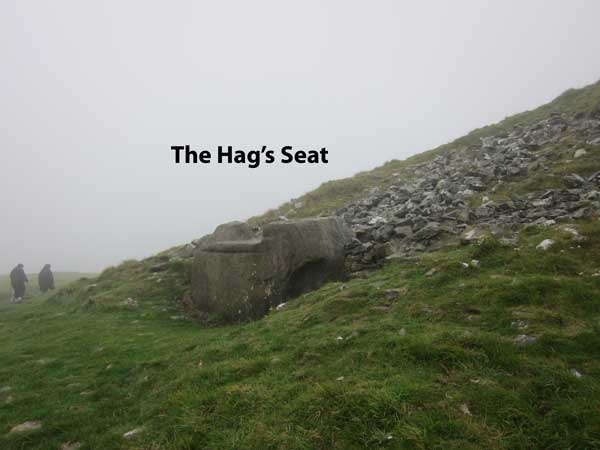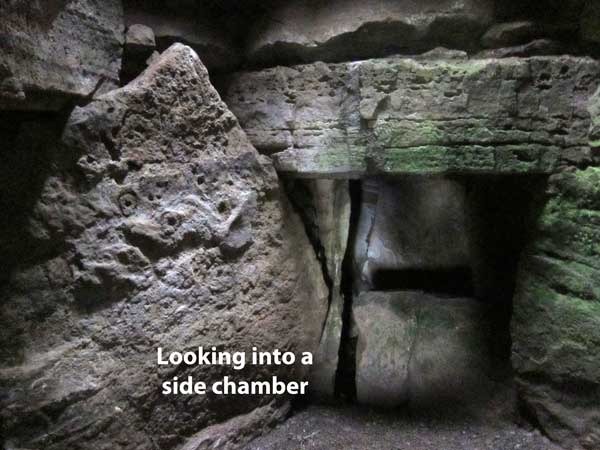Searching for Sunrise in a Megalithic Cemetery, Ireland
Cautiously, my husband Gary, our friend Michael, and I followed a nearly invisible path through the fog and up the side of Loughcrew hill, just before sunrise. A huge crow—perhaps a raven—flew by, its wings flapping loudly in semi-darkness. We were heading to the ridge top to see a twice-a-year spectacle: the rays of the equinox sunrise penetrating the passageway of Cairn T, a 5,500-year-old megalithic tomb situated 52 miles northwest of Dublin. The equinoxes, which occur around March 21 and September 21, are the two times of year when the days and nights are of equal length.
Distant drumming drifted through the swirling mist, along with the faint sound of voices. Others had reached the site before us. Soon we arrived at the top. A large mound of mist-sparkled green grass and rocks, Cairn T looked like an immense, squat mushroom, partly encircled with huge kerbstones. A number of ruined, exposed stone chambers and tumbled stones were scattered over the hillside. Clumps of people milled around, seeking shelter, chanting, or sharing mugs of steaming coffee and pieces of cake. The event had the mixed flavor of a class reunion and a revival meeting.
The OPW (Office of Public Works) representative stood by the barred entrance to Cairn T, welcoming all comers. We introduced ourselves and discussed the probability of seeing the sun rise. Not likely, was the conclusion. Shivering, our breath adding to the mist, we walked around to keep warm.
Loughcrew Megalithic Cemetery is also known as Sliabh na Caillí, Slieve na Cailliagh, the Hill of the Hag, the Cairn of the Witch, the Mountain of the Sorceress, the Witches Hops—you get the idea. Located in the northeast of the Republic of Ireland, it is one of the four largest Irish megalithic cemeteries. More than thirty chambered cairns, many with interior stone carvings, cover a ridge of three hills. The passage graves, built between 3500 and 3300 BCE, are constructed of sandstone, a coarse greywacke called gritstone, and conglomerate.
The Loughcrew cairns are divided into Carnbane East and Carnbane West. Cairn T, AKA The Hag’s Cairn, is the largest on Carnbane East. Oriented slightly south of east, it is 120 feet in diameter and 369 feet in circumference. Fragments of charred bones, charcoal, and a bronze pin were found during the original excavation.
Cairn T passage grave is shaped like a cross, or perhaps more accurately, like a human body. The narrow, low entry passage opens into a 10-foot-high domed chamber. On three sides of the chamber are side niches or alcoves, also domed, their entrances partially blocked by threshold stones. Several of the uprights in the passageway and in the inner chamber are decorated with geometric patterns, including concentric circles and zigzags, “combs” and ovals, and “’flower” and “sun” motifs. Most impressive is the ornately carved backstone of the rear chamber, which is lit by a beam of light during spring and fall equinox sunrises. That’s what we were there to see.
Loughcrew is called Slieve na Cailleach, a reference to the “Old Hag”—the Cailleach—to whom the hill is dedicated. Dark goddess of the earth, Hag of Winter, she supposedly resided over the area and made her home here, in this place, within this cairn. The word “Cailleach” (KAL-y-ak) comes from “old veiled one”; caille means veil or caul. The Cailleach was the ancestral goddess found throughout Ireland and Scotland, and each tribe had its Cailleach. Numerous mountain ranges and large hills are said to have been formed when she accidently dropped rocks out of her apron.
She has similarities to the Hindu goddess Kali, another powerful transformative “dark” goddess. The Cailleach represents death and rebirth, transformation and winter, in contrast to Brigid, the goddess—and later Christian saint—associated with healing, creative inspiration, eternal flame, and springtime. In Irish myth, the Cailleach and Brigid are understood to be in an ongoing struggle, paired goddesses who trade places twice a year. The Cailleach’s time is said to begin at Samhain (1 November) and end on Imbolc (1 February), while Brigid rules the rest of the year.
Dark and light juxtapose within Cairn T through the penetrating rays of the equinox sunrise. I wondered whether perhaps the event was a visual marker of the boundaries of wintertime: the coming of autumn and the arrival of spring. But would we get to see it? I doubted it.
While we waited to be allowed into the chamber, we walked over to the Hag’s Chair on the north side of Cairn T. The “chair” is actually a massive kerbstone shaped into a bench and has barely discernable carvings on the front side. At some point in time, a cross was carved into the seat, perhaps in the eighteenth century when public Catholic ritual was forbidden. It might then have served as an altar during secret outdoor Masses.
The chair-like stone is sometimes called the Seat of Ollamh Fodhla, said to have been the first law-giver of Ireland, and is also known as the Seat of the Cailleach. Folklore records that you can sit there and make a wish—but only one. I levered my way up to the seat and, legs dangling, made a wish—but only one.
The distant horizon remained shrouded in clouds as the OPW guide began to let small groups enter the cairn. We waited patiently, watching our breath shimmer in the chill dawn air. Soon our turn came, and as I made my way down the dark passageway, I aimed my flashlight at the large upright stones, puzzling over the enigmatic carvings.
As we huddled together in the cramped interior, one woman brought out a frame drum and started to beat it in a slow, rhythmic fashion. Another woman joined in. Soon the chamber began to resonate, the ancient stones responding to the vibration. The drums seemed to get louder and to be joined by others, though there were no others visible. The atmosphere shifted and cleared. I held my breath, caught for a moment outside of time and place. Perhaps—perhaps the Cailleach still resided inside this chamber and we had wakened her….
Silence descended, broken only by the heartbeat of the drums.
I was sitting in the circle, pressed against the threshold stone at the rear alcove. Recognizing my opportunity, I climbed over the stone and crouched in the tiny chamber. I placed my hand against the eight-lobed petal carved into the backstone. No sunrays illuminated its deep-cut form, but I could see it with my fingers. It resembled the modern symbol for an atom—eight swirling planes of energy centered on a single point. Or maybe it resembled a flower, pressed flat against the wall. Or maybe it represented the sun, the light of which penetrated exactly to this spot on a clear equinox morning—although this morning there was no such sunbeam.
What did it all mean? Why did the megalith builders design this so-called tomb? Even if human remains had been found there, to call it a “tomb” is like calling Westminster Cathedral a burial chamber because people are buried there. Obviously, it had other purposes or the constructors would not have aligned its passage—and the rear niche—with the rising equinox sun. They would not have engraved the mysterious designs into the stones.
I looked around, beginning to make out individual faces in the breaking dawn. We were spending time together in this sacred space, listening quietly to the beating drums. Perhaps this was the purpose, the meaning: Cairn T was a place where people came together and shared a communal experience. Or maybe not. Perhaps 5,500 years ago only religious specialists were permitted to enter the holy chamber, while the rest of the tribe stood outside shivering in the cold.
Daylight burned through the mist and the chamber grew lighter, but the sun was now too high above the horizon to enter the passageway. The drumming stopped. Slowly the space filled with the sound of rustling clothes and whispering voices. It was time to leave.
(The following is an excellent website link to see the sunrise at Loughcrew: http://www.knowth.com/loughcrew.htm)
Elyn Aviva is a writer, fiber artist, and transformational traveler. Currently living in Girona (Catalonia), Spain, she is fascinated by pilgrimage and sacred sites. Her PhD in anthropology was on the modern Camino de Santiago in Spain. Aviva is author of a number of books on pilgrimage and journey, and she is co-author with her husband, Gary White, of “Powerful Places Guidebooks”; the most recent one is Powerful Places in Ireland. Powerful Places in Wales is forthcoming. To learn more about Elyn or her publications, go to www.pilgrimsprocess.com and www.powerfulplaces.com and www.fiberalchemy.com


